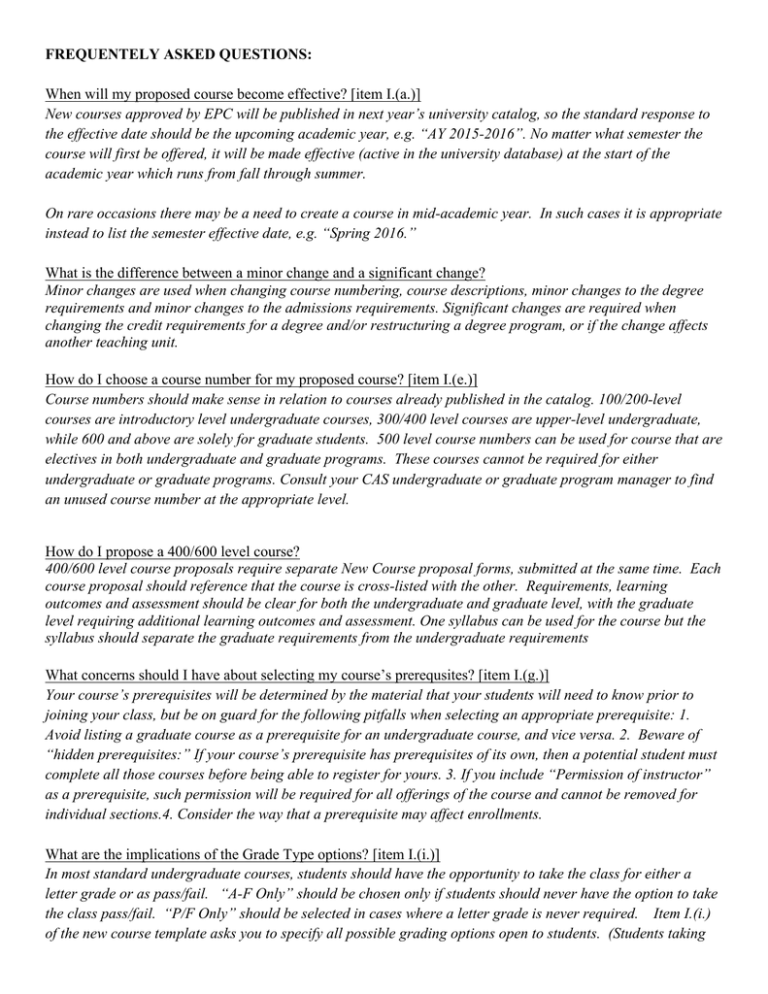FREQUENTELY ASKED QUESTIONS:
advertisement

FREQUENTELY ASKED QUESTIONS: When will my proposed course become effective? [item I.(a.)] New courses approved by EPC will be published in next year’s university catalog, so the standard response to the effective date should be the upcoming academic year, e.g. “AY 2015-2016”. No matter what semester the course will first be offered, it will be made effective (active in the university database) at the start of the academic year which runs from fall through summer. On rare occasions there may be a need to create a course in mid-academic year. In such cases it is appropriate instead to list the semester effective date, e.g. “Spring 2016.” What is the difference between a minor change and a significant change? Minor changes are used when changing course numbering, course descriptions, minor changes to the degree requirements and minor changes to the admissions requirements. Significant changes are required when changing the credit requirements for a degree and/or restructuring a degree program, or if the change affects another teaching unit. How do I choose a course number for my proposed course? [item I.(e.)] Course numbers should make sense in relation to courses already published in the catalog. 100/200-level courses are introductory level undergraduate courses, 300/400 level courses are upper-level undergraduate, while 600 and above are solely for graduate students. 500 level course numbers can be used for course that are electives in both undergraduate and graduate programs. These courses cannot be required for either undergraduate or graduate programs. Consult your CAS undergraduate or graduate program manager to find an unused course number at the appropriate level. How do I propose a 400/600 level course? 400/600 level course proposals require separate New Course proposal forms, submitted at the same time. Each course proposal should reference that the course is cross-listed with the other. Requirements, learning outcomes and assessment should be clear for both the undergraduate and graduate level, with the graduate level requiring additional learning outcomes and assessment. One syllabus can be used for the course but the syllabus should separate the graduate requirements from the undergraduate requirements What concerns should I have about selecting my course’s prerequsites? [item I.(g.)] Your course’s prerequisites will be determined by the material that your students will need to know prior to joining your class, but be on guard for the following pitfalls when selecting an appropriate prerequisite: 1. Avoid listing a graduate course as a prerequisite for an undergraduate course, and vice versa. 2. Beware of “hidden prerequisites:” If your course’s prerequisite has prerequisites of its own, then a potential student must complete all those courses before being able to register for yours. 3. If you include “Permission of instructor” as a prerequisite, such permission will be required for all offerings of the course and cannot be removed for individual sections.4. Consider the way that a prerequisite may affect enrollments. What are the implications of the Grade Type options? [item I.(i.)] In most standard undergraduate courses, students should have the opportunity to take the class for either a letter grade or as pass/fail. “A-F Only” should be chosen only if students should never have the option to take the class pass/fail. “P/F Only” should be selected in cases where a letter grade is never required. Item I.(i.) of the new course template asks you to specify all possible grading options open to students. (Students taking the course for credit in a major can still be required to take the course only for letter grade by means of the degree program requirements, not by limiting the grade option here in the course proposal.) Graduate students must take all courses “A-F,” unless the course is designated “May be taken P/F Only.” Standard graduate courses should have a grade option of “A-F Only.” Courses numbered -797, 799, -898, -899 are given the “SP/UP Only” graduate option. Will indicating a General Education course in the EPC proposal automatically start the process for Gen Ed approval? [item I. (k.) i. ] The General Education Program has its own application process to designate a course as part of the Gen Ed program. That process runs independently of the EPC process, but can run concurrently with it. Indicating here your intention to apply for Gen Ed credit alerts the registrar’s staff to coordinate the two applications once your EPC proposal has passed all steps of the approval process and has arrived at the Office of the University Registrar for processing. Contact the General Education coordinator via email at gened@american.edu for more information. Should I indicate whether my course is an online course or a hybrid? [item I.(k.) ii and iii] Any course can be converted into an online or hybrid course for a given semester. Indicating online or hybrid here in the New Course Proposal states that the course would only be offered in the format that you indicate. How does a Rotating Topics course differ from a Non-Recurring Selected Topics course? [item I.(k.)iv.] Experimental topics are offered as Non-recurring Selected Topics with, Non-Recurring course numbers that usually end in –x96. These topics courses may only be offered twice; under that course number, after which time they must be converted either to stand alonga regular courses in the university catalog or offered as part of a Rotating Topics course. Rotating Topics courses address specific topics each semester under the umbrella of a related field that is indicated by the course name. For example: Econ 458 The Economics of World Regions might be offered as Econ 458.002 The Economics of the Middle East. Topics taught under these course numbers are not limited in the number of times they may be offered. Any course number can be used for rotating topics, which are usually designated by the comment “Topics vary by section…” at the start of the course description. You may also indicate in the course proposal whether students can earn academic credit by taking more than one topic under the same course number. How can I determine prior enrollment history for this course? [item II.(c.)] Many new courses are first offered as experimental topics under Non-recurring Selected Topics, Non-Recurring course numbers. Your program administrative staff, the College’s undergraduate program manager, or its Director of Graduate Programs can provide you prior enrollment history for inclusion in your proposal. Past enrollment history should support your realistic projection for future enrollment of the new course. New courses which have not been offered as a Non-recurring Selected Topics course will not have an enrollment history. What is the effect of my proposal on classroom space or other program facilities? [item II. (f.)(g.)] Indicate whether or not your proposed course will require a university classroom, computer lab, or other specialized space. If it does not, in what space will it meet? University classrooms are allocated to academic programs by the dean’s office. Do I need to include correspondence with other departments and units? Yes. New course, significant changes to an existing course, and new degree proposals will ask for communication correspondence to be provided. For example, the new course proposal states “Please indicate other units that offer courses or programs related to the proposed course and provide documentation of consultations with those units.” Please include all email correspondence with departments and units in an appendix to your proposal. How do I develop learning outcomes for the course and how are those outcomes assessed? [item II.(j.)(k.)] The University provides many guides for developing appropriate learning outcomes and assessment tools. Your own academic unit has probably designated one or more faculty members as assessment coordinators. The Center for Teaching, Research and Learning has a “best practices” guide for faculty that can be found under the Teaching and Learning Resources link of the CTRL Web site: http://www.american.edu/ctrl/index.cfm . The Office of Institutional Research and Assessment also provides templates, samples, and guidance at its Web site: http://www.american.edu/provost/assessment/index.cfm . How do I format for a course description for the university catalog? [item III.(a.)] Course information is available in the online catalog and at the back of the print catalog. The standard format for a course listing in the catalog follows this structure: Course prefix and number, followed by the course title. Credit hours in parenthesis. Course description (generally 50 words or fewer). Cross listed courses, if any. Usual semester of offering. Prerequisites, if any. Example: ARTH-423 East-West Photography (3) Examines the emergence of photography and the medium’s pivotal role in shaping relations between Asia and the West. Examines early portraiture, architectural sites, colonial tourism, photojournalism, family photographs and contemporary photography. Meets with ARTH-623. Usually offered alternate years. Prerequisite: ARTH-225 or ANRTH-320. What is needed for the catalog copy section of the proposal? Best practice is too use the old catalog copy to outline your changes. Please sStrikethrough old language/courses and denote your changes in red. Markup and comment boxes are not required. Example: EDU-666 Legal Issues in Education (3) For advanced graduate students. Study of student-institution relationship, institutional judicial systems, student rights, records, and due process issues. Usually offered in alternate years. How do I propose a new degree program? Please contact your CAS EPC administrator for further details. All new degree programs must be approved by the Office of the Provost before moving forward.



